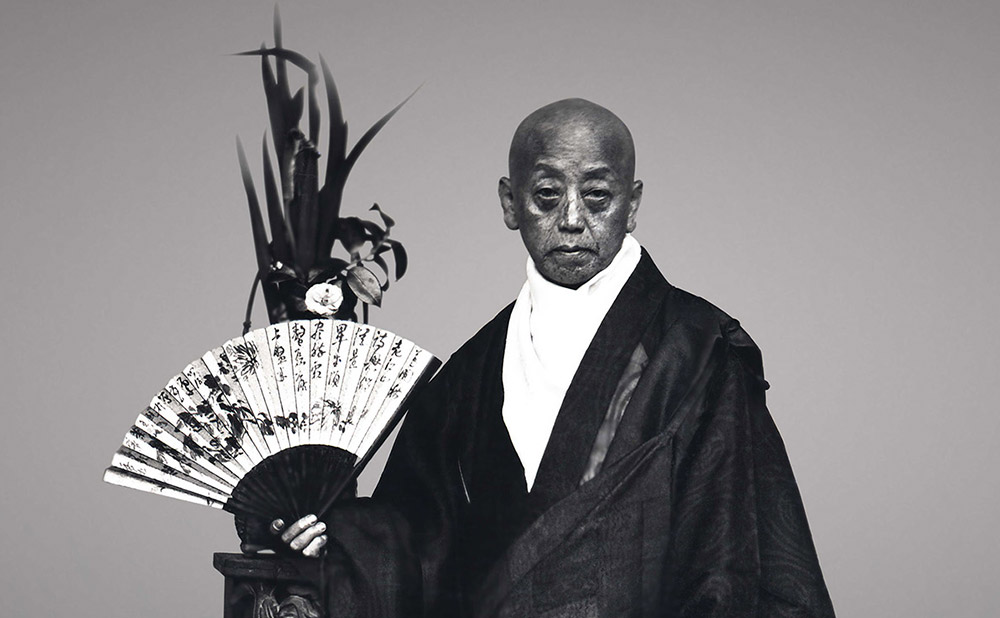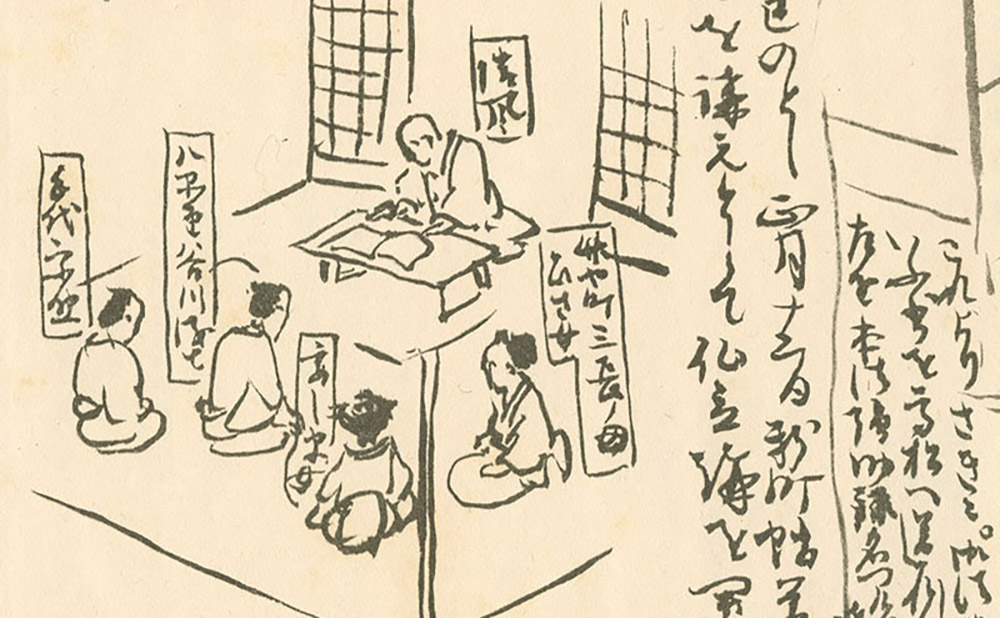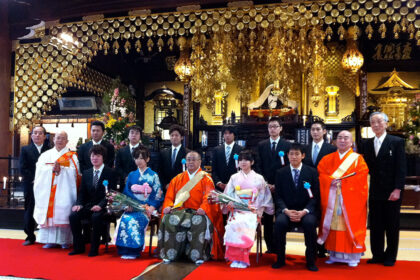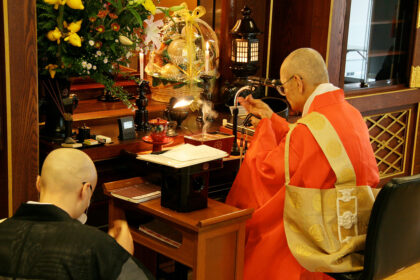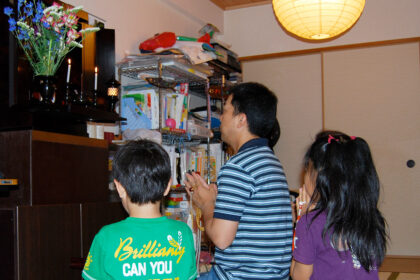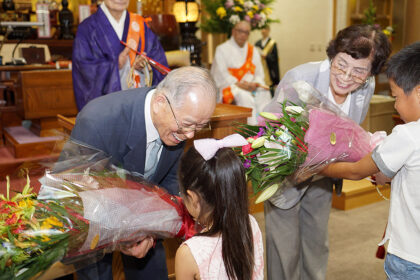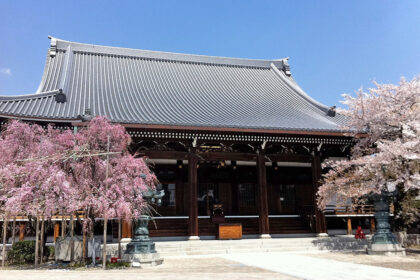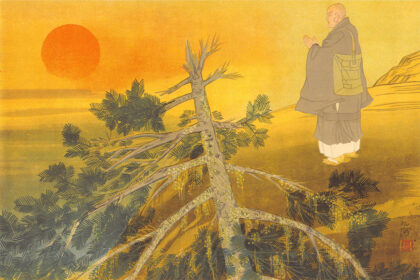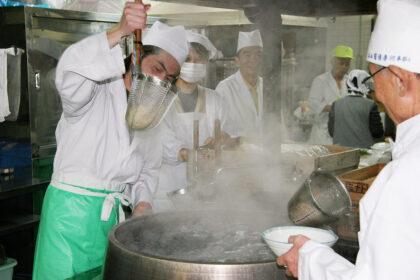Nissen Shōnin was born on April 1, 1817 (Bunka 14), in Ubayana-chō, west of Takoyakushi Muromachi, Kyoto. His father, Jōki Ōji, and his mother, Sumi (later renamed Kuni), named him Senjirō in childhood. He was born into a family renowned for its excellence in the literary arts, and from an early age, he showed remarkable talent in calligraphy, painting, and poetry. By the age of ten, his abilities were already recognized, earning him a place in Kyoto’s annual art almanac. At 25, his exceptional literary prowess was further demonstrated when he delivered lectures on The Tale of Genji at the residence of the nobleman Arikoto Chigusa.
At the age of 26, the passing of his beloved mother deeply grieved him, intensifying his interest in Buddhism. Though he explored various religious teachings, he found none that fulfilled his spiritual aspirations. While continuing his search, he also ran a private school where he taught calligraphy and poetry.
In 1845 (Kōka 2), at the age of 29, Nissen Shōnin organized an exhibition of his calligraphy at Chōon-in, a tacchū (sub-temple) within the grounds of Honmon Hokke-shū’s Honno-ji Temple. During this event, he encountered Reverend Zuikōin Nichiō Shūden, the chief priest of Chōon-in, who introduced him to the profound teachings of the Lotus Sutra. Deeply moved, Nissen Shōnin wholeheartedly embraced the faith and soon became a devoted disciple, studying under Nichijō, the head priest of Honno-ji.
As his dedication to the Lotus Sutra deepened, Nissen Shōnin resolved to take monastic vows. On April 28, 1848 (Kaei 1), he received ordination from Reverend Mujaku Nichiyō at Ryūsen-ji Temple in Tsuimura, Awaji Island, officially becoming a Buddhist priest at the age of 32.
Following his ordination, he sought to further his studies at the Danrin, a prestigious Buddhist academy at Honkō-ji Temple in Amagasaki. However, his growing reputation provoked envy, leading to his exclusion. Undeterred by this setback, Nissen Shōnin resolved to spread the teachings of the Lotus Sutra outside the confines of institutional Buddhism, dedicating himself to propagating the faith among the common people.
In 1850 (Kaei 3), a doctrinal dispute arose within the Honmon Hokke-shū sect at the residence of Miyawaki Takamatsu in Sanuki Province (modern-day Kagawa Prefecture). The debate, sparked by a disagreement between the court noble Yoriake Matsudaira and the monk Shushin, centered on the doctrine of Sanzujōfu (*1). Nissen Shōnin, together with progressive monks such as Nichijō, Nichiō, and Nichiyō, upheld the principle that Buddhahood could only be attained through the direct verbal recitation of Odaimoku (Namu Myōhō Renge Kyō) by human beings. This stood in contrast to the increasingly popular belief that mere dedication of merit through memorial services was sufficient for enlightenment. As the dispute failed to be resolved within the sect, Nissen Shōnin made a decisive move—establishing Honmon Butsuryū Kō, the forerunner of Honmon Butsuryū Shū, to preserve the pure teachings passed down from Nichiren and Nichiryū Shōnin.
Thus, on January 12, 1857 (Ansei 4), Nissen Shōnin formally founded Honmon Butsuryū Kō at the residence of his follower, Asashichi Tanigawa, in Happondō, south of Shimmachi Takoyakushi, Kyoto. The fledgling movement began humbly, with only a handful of dedicated followers.
Despite facing relentless persecution—including slander, opposition from neighboring residents and clergy, and even imprisonment on three occasions—Nissen Shōnin remained steadfast. The undeniable spiritual benefits and visible blessings experienced by his followers led to the rapid growth of the movement.
By 1878 (Meiji 11), Nissen Shōnin had established Myōkō Ichiza, a distinctive ritual and doctrinal system embodying the authentic teachings of Nichiren and Nichiryū Shōnin. In 1881 (Meiji 14), the 600th Anniversary Memorial Service for Nichiren Shōnin, held at Yūsei-ji shinkaijō (the predecessor of the present-day head temple, Yūsei-ji), attracted an astonishing 15,000 devotees. In 1883 (Meiji 16), after appointing his successor, Nichimon Shōnin, as the head priest of Yūsei-ji, Nissen Shōnin relocated to his private residence on Fuyachō Ayakōji, where he devoted himself to training disciples.
On July 17, 1890 (Meiji 23), while traveling by boat down the Yodo River to the Tamae Group Dōjō in Osaka, Nissen Shōnin paused to rest at the teahouse of Iroku Morita in Moriguchi, seeking respite from the midday heat. As evening approached, signs of his impending passing became evident. At approximately 5:25 PM, in a state of peaceful composure, he entered parinirvāṇa at the age of 74. His body was then transported to the Tamae Group Dōjō, where a solemn wake was held. On August 5, his grand funeral took place at Yūsei-ji, attended by over 2,000 mourners.
(*1) The Sanzujōfu Controversy—The Debate on Attaining Buddhahood in the Three Lower Realms
In Buddhist doctrine, attaining Buddhahood traditionally requires one to walk the Bodhisattva path—reciting Odaimoku oneself and encouraging others to do so. However, a mistaken belief emerged that even animals, such as dogs and cats, could attain Buddhahood if someone chanted the Lotus Sutra on their behalf and transferred merit to them. This led to a heated debate over the legitimacy of such a notion.
The belief in animal enlightenment arose from corrupt Buddhist clergy of the time, who prioritized conducting memorial services for the deceased while neglecting the spiritual salvation of the living. This deviation from the Lotus Sutra and Nichiren Buddhism deeply concerned Nissen Shōnin, who firmly opposed the erroneous view, advocating instead for the direct, conscious practice of chanting Odaimoku as the true path to enlightenment.

